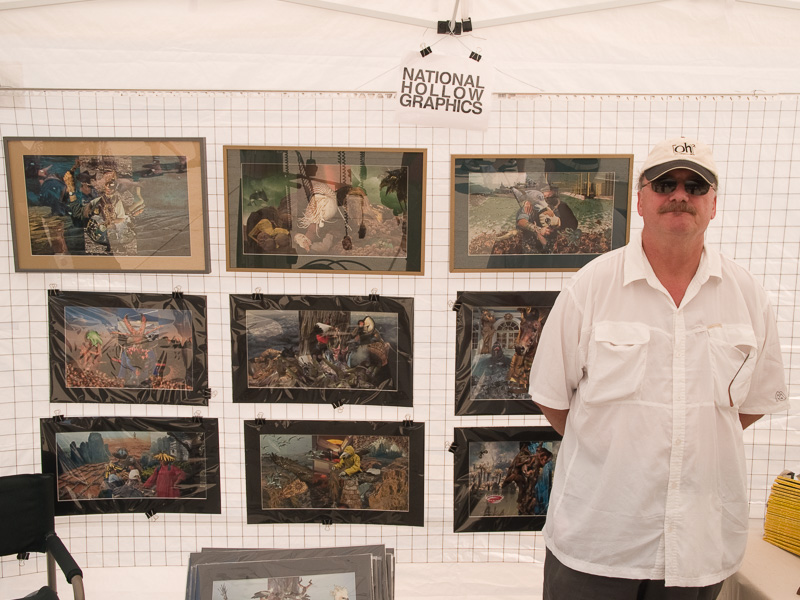
A friend of ours, David Hynes, was showing his mixed media works (i.e. collages) in this year’s iteration of the Toronto Outdoor Art Exhibition down at Nathan Phillips Square. The show itself was a mixed bag, trying (a little bit unsuccessfully) to walk that narrow path between popular appeal and artistic integrity. There were scads of artisans displaying their neo-romantic pap that would be sure to tug at the heart strings—and purse strings—of the genteel folk from the burbs. But there was also a sizable gathering of artists who know what they’re doing. This popular/legitimate dichotomy is pretty much analogous to the comatose/wide awake dichotomy. Most of us, most of the time, are asleep to the more immediate ways our culture touches us; sadly, some are narcoleptic; but for most, we find ourselves periodically jolted from our slumbers so that we can participate for a time. I’m pleased to announce that, when we ran into David Hynes, he was wide awake. His collages are ample evidence of this. His collages look in two directions: they look backward with an obvious debt to their sources, but they look forward with strikingly surreal images that are fresh and have an immediacy that makes it easy to believe (mistakenly) that they have been digitally generated.
I was particularly taken by his “National Hollow Graphics” series. He took issues of the National Geographics Magazine and, for each issue, produced a collage solely from images found in that issue. When he had completed the series, he stacked the used issues and “sealed” them with a C-clamp so that he wouldn’t use them again. The used-up issues looked a bit like orange peels after they have been squeezed dry in a juicer. The process reminds me of Keats’ sonnet, “Nuns fret not at their narrow convent cell …” Although the discipline seems limiting, whether writing poetry according to seemingly arbitrary rules or creating collages according to self-imposed restrictions, nevertheless it is a paradox of creativity that it is precisely in the tightest confines that one discovers the greatest freedom. Perhaps, because it is more challenging to produce work that is fresh, one works harder to do so. Perhaps one brings to the project a heightened intentionality. Whatever the reason, the results of Mr. Hynes’ efforts bear out my observation. Be sure to view them at his website: www.davidhynes.net.
The collages also made me mindful of the emerging proprietary rights/cultural freedom debate. Click on my “copyright” category for more about the potentially self-negating efforts of the powerful American copyright lobby which asserts a rights-based notion of our cultural “products.” By definition, collages are derivative works—they are created from the creativity of others. On one view, David Hynes has “stolen” images which are owned by the National Geographic Society. On another view, David Hynes is participating in an amorphous process which is essential to our sense of a collective identity. In Canada, the latter view still prevails; but in America, things have grown murky.
What can we say about the source of David’s images? Technically, the National Geographic Society owns the images which appear in its magazines, but the notion of ownership does not sit easily with the NGS’s roles as charitable organization, as documenter of endangered ecosystems and vanishing cultures, as public educator, as an historic institution intimately tied to our identity as a people (as a species?). For many Americans (and Canadians), the NGS has been their only window onto the rest of the world; its images of the other, the different, the strange, the foreign, have been for many the primary point of reference from which to measure their own sense of identity. And yet, all these images, and their accompanying commentaries, are not really images of the other, the different, the strange, the foreign; more than anything else, they function as an affirmation of what it means to be American. The NGS does not educate us so much about distant places as it does about the ground where we stand. And so, when someone like David Hynes chooses to dissect and rearrange those images, this becomes something of a meditation, a gaze inward, a reflection on what it means to be one of the people who stands on this side of the NGS window. The results are emphatically not “pretty pictures” to hang over the mantle beside the lovely ivory carvings from Botswana and the teak figurines from Java.
Today, there comes a point in the arc of the creative trajectory when one reaches an escape velocity. The gravity of modern notions (like a fixed place, a clear point of view, the certainty of the other’s otherness) can no longer hold the artist in its orbit. The artisans continue to whirl around in their ellipses, returning us to places we have already tracked, but even dead balls of rock can do that. The instant one comes awake to one’s position on the trajectory, one must plot a new course. This is not merely a possibility; it is a necessity. One can never again look at a photograph of Kikuyu standing on a plain in Kenya and say: “Look at the strange, brown-skinned tribal people; thank God I don’t live like that.” Art—David Hynes’ art—becomes political. A fresh way of looking at photographs fosters a fresh way of looking at ourselves and our relation to the other. Quite possibly, it points us to a path that leads to a saner life.